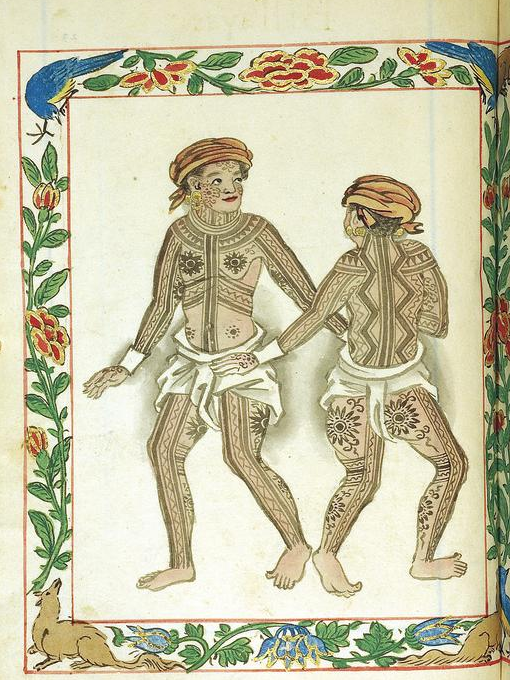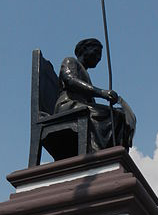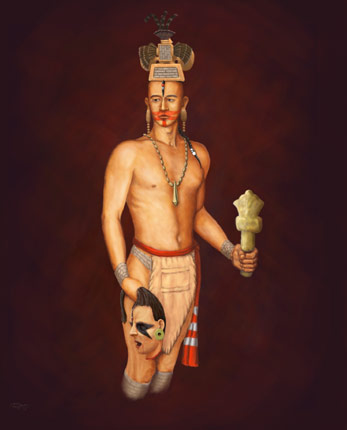|
Batok
Batok, batek, patik, or batik, among other names, are general terms for indigenous tattoos of the Philippines. Tattooing on both sexes was practiced by almost all ethnic groups of the Philippine Islands during the pre-colonial era. Like in other Austronesian groups, these tattoos were made traditionally with hafted tools tapped with a length of wood (called the "mallet"). Each ethnic group had specific terms and designs for tattoos, which are also often the same designs used in other artforms and decorations like in pottery and weaving. Tattoos range from being restricted only to certain parts of the body to covering the entire body. Tattoos were symbols of tribal identity and kinship, as well as bravery, beauty, and social or wealth status. Tattooing traditions were lost as Filipinos were converted to Christianity during the Spanish colonial era. Tattooing were also lost in some groups (like the Tagalog and the Moro people) shortly before the colonial period due to their ... [...More Info...] [...Related Items...] OR: [Wikipedia] [Google] [Baidu] |
Whang-od Tattooing
Whang-od Oggay (First name pronunciation: ; born February 17, 1917), also known as Maria Oggay, is a Filipina tattoo artist from Buscalan, Tinglayan, Kalinga, Philippines. She is often described as the "last" and oldest '' mambabatok'' (traditional Kalinga tattooist) and is part of the Butbut people of the larger Kalinga ethnic group. She has been tattooing headhunters and women of the indigenous people of Butbut in Buscalan, Kalinga, since she was 15 years old, but the Butbut warriors who used to earn tattoos by protecting villages or killing enemies no longer exist. Despite this, Whang-od continues to practice her traditional art form on tourists visiting Buscalan. The National Commission for Culture and the Arts (NCCA) conferred on Whang-od the prestigious ''Dangal ng Haraya Award'' at Tabuk, the capital of Whang-od's ethnic province of Kalinga, in 2018. She was nominated for the National Living Treasures Award (Gawad Manlilikha ng Bayan) in 2017. Her nomination is s ... [...More Info...] [...Related Items...] OR: [Wikipedia] [Google] [Baidu] |
Austronesian Peoples
The Austronesian peoples, sometimes referred to as Austronesian-speaking peoples, are a large group of peoples in Taiwan, Maritime Southeast Asia, Micronesia, coastal New Guinea, Island Melanesia, Polynesia, and Madagascar that speak Austronesian languages. They also include indigenous ethnic minorities in Vietnam, Cambodia, Myanmar, Thailand, Hainan, the Comoros, and the Torres Strait Islands. The nations and territories predominantly populated by Austronesian-speaking peoples are sometimes known collectively as Austronesia. Based on the current scientific consensus, they originated from a prehistoric seaborne migration, known as the Austronesian expansion, from pre- Han Taiwan, at around 1500 to 1000 BCE. Austronesians reached the northernmost Philippines, specifically the Batanes Islands, by around 2200 BCE. Austronesians used sails some time before 2000 BCE. In conjunction with their use of other maritime technologies (notably catamarans, outrigger boats, ... [...More Info...] [...Related Items...] OR: [Wikipedia] [Google] [Baidu] |
Tattooing
A tattoo is a form of body modification made by inserting tattoo ink, dyes, and/or pigments, either indelible or temporary, into the dermis layer of the skin to form a design. Tattoo artists create these designs using several tattooing processes and techniques, including hand-tapped traditional tattoos and modern tattoo machines. The history of tattooing goes back to Neolithic times, practiced across the globe by many cultures, and the symbolism and impact of tattoos varies in different places and cultures. Tattoos may be decorative (with no specific meaning), symbolic (with a specific meaning to the wearer), or pictorial (a depiction of a specific person or item). Many tattoos serve as rites of passage, marks of status and rank, symbols of religious and spiritual devotion, decorations for bravery, marks of fertility, pledges of love, amulets and talismans, protection, and as punishment, like the marks of outcasts, slaves and convicts. Extensive decorative tattooing has als ... [...More Info...] [...Related Items...] OR: [Wikipedia] [Google] [Baidu] |
Bahag (garment)
Bahag is a loincloth that was commonly used by men throughout the pre-colonial Philippines. They were either made from barkcloth or from hand- woven textiles. Before the colonial period, bahag were a common garment for commoners and the serf class (the ''alipin'' caste). Bahag survives in some indigenous tribes of the Philippines today - most notably the Cordillerans in Northern Luzon. Description The specific way to wear it involves first pulling the long piece of cloth (usually around ) in between the legs and covering the genitals, with a longer back part. The back part is then twisted across the right leg and across the waist in an anti-clockwise direction. It goes under the flap of the front part and across the left leg. It is twisted back across the back loop above the buttocks. The result resembles two rectangles of cloth hanging in front of and behind the waist, with a loop around the legs resembling a belt. The design of the weave is often unique to the tribe of the pers ... [...More Info...] [...Related Items...] OR: [Wikipedia] [Google] [Baidu] |
Visayan People
Visayans (Visayan: ''mga Bisaya''; ) or Visayan people are a Philippine ethnolinguistic group or metaethnicity native to the Visayas, the southernmost islands of Luzon and a significant portion of Mindanao. When taken as a single ethnic group, they are both the most numerous in the entire country at around 33.5 million, as well as the most geographically widespread. The Visayans broadly share a maritime culture with strong Roman Catholic traditions integrated into a precolonial indigenous core through centuries of interaction and migration mainly across the Visayan, Sibuyan, Camotes, Bohol and Sulu seas. In more inland or otherwise secluded areas, ancient animistic-polytheistic beliefs and traditions either were reinterpreted within a Roman Catholic framework or syncretized with the new religion. Visayans are generally speakers of one or more of the Bisayan languages, the most widely spoken being Cebuano, followed by Hiligaynon (Ilonggo) and Waray-Waray. Terminology ''Kabi ... [...More Info...] [...Related Items...] OR: [Wikipedia] [Google] [Baidu] |
Visayans 1
Visayans ( Visayan: ''mga Bisaya''; ) or Visayan people are a Philippine ethnolinguistic group or metaethnicity native to the Visayas, the southernmost islands of Luzon and a significant portion of Mindanao. When taken as a single ethnic group, they are both the most numerous in the entire country at around 33.5 million, as well as the most geographically widespread. The Visayans broadly share a maritime culture with strong Roman Catholic traditions integrated into a precolonial indigenous core through centuries of interaction and migration mainly across the Visayan, Sibuyan, Camotes, Bohol and Sulu seas. In more inland or otherwise secluded areas, ancient animistic-polytheistic beliefs and traditions either were reinterpreted within a Roman Catholic framework or syncretized with the new religion. Visayans are generally speakers of one or more of the Bisayan languages, the most widely spoken being Cebuano, followed by Hiligaynon (Ilonggo) and Waray-Waray. Terminolo ... [...More Info...] [...Related Items...] OR: [Wikipedia] [Google] [Baidu] |
Tagalog People
The Tagalog people ( tl, Mga Tagalog; Baybayin: ᜋᜅ ᜆᜄᜎᜓᜄ᜔) are the largest ethnolinguistic group in the Philippines, numbering at around 30 million. An Austronesian people, the Tagalog have a well developed society due to their cultural heartland, Manila, being the capital city of the Philippines. They are native to the Metro Manila and Calabarzon regions of southern Luzon, and comprise the majority in the provinces of Bulacan, Bataan, Nueva Ecija and Aurora in Central Luzon and in the islands of Marinduque and Mindoro in Mimaropa. Etymology The commonly perpetuated origin for the endonym "Tagalog" is the term ''tagá-ilog'', which means "people from longthe river" (the prefix ''tagá-'' meaning "coming from" or "native of"). However, this explanation is a mistranslation of the correct term ''tagá-álog'', which means "people from the ford". Historical usage Before the colonial period, the term "Tagalog" was originally used to differentiate rive ... [...More Info...] [...Related Items...] OR: [Wikipedia] [Google] [Baidu] |
Kapampangan People
The Kapampangan people ( pam, Taung Kapampangan), Pampangueños or Pampangos, are the sixth largest ethnolinguistic group in the Philippines, numbering about 2,784,526 in 2010. They live mainly in the provinces of Pampanga, Bataan and Tarlac, as well as Bulacan, Nueva Ecija and Zambales. Overview The province of Pampanga is the traditional homeland of the Kapampangans. Once occupying a vast stretch of land that extended from Tondo to the rest of Central Luzon, huge chunks of territories were carved out of Pampanga so as to create the provinces of Bulacan, Bataan, Nueva Ecija, Aurora and Tarlac.Henson, Mariano A. 1965. ''The Province of Pampanga and Its Towns: A.D. 1300–1965''. 4th ed. revised. Angeles City: By the author. As a result, Kapampangans now populate a region that extends beyond the political boundaries of the small province of Pampanga. In the province of Tarlac, the indigenous population of Tarlac City and the municipalities of Bamban, Capas and Concepcion ar ... [...More Info...] [...Related Items...] OR: [Wikipedia] [Google] [Baidu] |
Ancestor Spirit
The veneration of the dead, including one's ancestors, is based on love and respect for the deceased. In some cultures, it is related to beliefs that the dead have a continued existence, and may possess the ability to influence the fortune of the living. Some groups venerate their direct, familial ancestors. Certain sects and religions, in particular the Eastern Orthodox Church and Roman Catholic Church, venerate saints as intercessors with God; the latter also believes in prayer for departed souls in Purgatory. Other religious groups, however, consider veneration of the dead to be idolatry and a sin. In European, Asian, Oceanian, African and Afro-diasporic cultures, the goal of ancestor veneration is to ensure the ancestors' continued well-being and positive disposition towards the living, and sometimes to ask for special favours or assistance. The social or non-religious function of ancestor veneration is to cultivate kinship values, such as filial piety, family loy ... [...More Info...] [...Related Items...] OR: [Wikipedia] [Google] [Baidu] |
Apotropaic
Apotropaic magic (from Greek "to ward off") or protective magic is a type of magic intended to turn away harm or evil influences, as in deflecting misfortune or averting the evil eye. Apotropaic observances may also be practiced out of superstition or out of tradition, as in good luck charms (perhaps some token on a charm bracelet), amulets, or gestures such as crossed fingers or knocking on wood. Many different objects and charms were used for protection throughout history. Symbols and objects Ancient Egyptian Apotropaic magical rituals were practiced throughout the ancient Near East and ancient Egypt. Fearsome deities were invoked via ritual in order to protect individuals by warding away evil spirits. In ancient Egypt, these household rituals (performed in the home, not in state-run temples) were embodied by the deity who personified magic itself, Heka. The two gods most frequently invoked in these rituals were the hippopotamus-formed fertility goddess, Taweret ... [...More Info...] [...Related Items...] OR: [Wikipedia] [Google] [Baidu] |
Headhunting
Headhunting is the practice of hunting a human and collecting the severed head after killing the victim, although sometimes more portable body parts (such as ear, nose or scalp) are taken instead as trophies. Headhunting was practiced in historic times in parts of Europe, East Asia, Oceania, Southeast Asia, South Asia, Mesoamerica, West and Central Africa. The headhunting practice has been the subject of intense study within the anthropological community, where scholars try to assess and interpret its social roles, functions, and motivations. Anthropological writings explore themes in headhunting that include mortification of the rival, ritual violence, cosmological balance, the display of manhood, cannibalism, dominance over the body and soul of his enemies in life and afterlife, as a trophy and proof of killing (achievement in hunting), show of greatness, prestige by taking on a rival's spirit and power, and as a means of securing the services of the victim as ... [...More Info...] [...Related Items...] OR: [Wikipedia] [Google] [Baidu] |
Pedro Chirino
Pedro Chirino (1557 – 16 September 1635) was a Spanish priest and historian who served as a Jesuit missionary in the Philippines. He is most remembered for his work, ''Relación de las Islas Filipinas'' (1604), one of the earliest works about the Philippines and its people that was written. He was born in 1557 in the town of Osuna in Andalusia, Spain. A graduate in both civil and canon laws at Sevilla, he entered the Society of Jesus at age 23. He was soon appointed to the mission in the Philippines, arriving in the country in 1590 along with Gomez Perez Dasmariñas, the newly-appointed governor-general of the Philippines. He was first assigned to Balayan before he was appointed to be the parish priest of the town of Taytay in 1591. During his tenure as parish priest, he transferred the location of Taytay parish from its original site near Laguna de Bay to a hilltop area where it has remained to this day. He also began to immerse himself in the study of the Tagalog language and ... [...More Info...] [...Related Items...] OR: [Wikipedia] [Google] [Baidu] |








